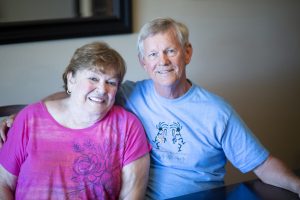- Slug: BC-CNS-Alzheimer’s Caregivers. 2,380 words.
- 3 photos and captions below.
- Carly Henry video here.
- Taniyah Williamson video here.
By CARLY HENRY
Cronkite News
PHOENIX – An estimated 5.7 million Americans have Alzheimer’s disease, with research and support focusing on those with the diagnosis. But their caregivers, who are often family and friends, also face devastating financial and lifestyle challenges.
People with moderate and late-stage Alzheimer’s rely heavily on the supervision and care of loved ones. Generations of family and friends who become caregivers learn about the disease as they encounter its progression, snipping at pieces of the sufferer’s identity. Decades-long relationships take new shapes, a morass of bureaucracy confounds initiates and major financial decisions affect income and lifestyles.
The number of people diagnosed with the disease – which has no survivors – is expected to more than double by 2050, according to the Alzheimer’s Association. Arizona has the second-highest growth rate for the disease in the country.
Still, some experts are optimistic. Eric Reiman, executive director of the Banner Alzheimer’s Institute, hopes to see a treatment to slow or halt the progression of the disease within six years.
“It takes an unacceptable toll on the affected person,” Reiman said. “But it takes an under appreciated and intolerable toll on family members across generations.”
Alzheimer’s, a degenerative brain disease, primarily affects people older than 65, though some people develop the disease in their 40s or 50s. There is no cure.
In the beginning stages, those with dementia may have difficulty recalling or keeping track of information that previously was routine, such as shopping for groceries. As the disease progresses and memory retention becomes more difficult, they may become more emotional, delusional, withdrawn and more likely to wander and get lost. Eventually, Alzheimer’s patients may lose their ability to hold conversations, walk and swallow, and become more vulnerable to infection. They may need 24-hour care.
Family turned caregiver network
Family and friends take on new and changing roles when someone they care about receives an Alzheimer’s diagnosis.
Emily Broughton’s grandmother, Barbara Phillips, was an independent woman who loved her family and rarely missed her grandchildren’s sporting events or extracurricular activities. But when Broughton was about 17, her grandmother started acting out of character. She forgot things and started telling family she was too busy to make plans with them.
When Phillips was diagnosed with Alzheimer’s, her entire family was transformed into a team of caregivers – taking turns watching her and helping her with everyday tasks.
“If someone has Alzheimer’s, it’s your children caring for you, your grandchildren,” said Broughton, 25, who moved from Ohio to Scottsdale in April 2017. “Everyone has to step up and take a role to care for that person.”
Broughton’s family learned what they could about the disease, but her grandmother did not accept the diagnosis, which made planning for the future difficult. Eventually, the family decided she would be safer in a nursing home.
“When it came time to sell her clothes and her house, she had no input in those things because in the beginning stages, she never admitted she had Alzheimer’s,” Broughton said.
Caring for Phillips was tough on Broughton’s family at times; in time, someone stayed by her grandmother’s side every hour of the day. And people with Alzheimer’s can become angry and agitated for reasons unapparent to others.
Phillips once called her family in the middle of the night to tell them her house was on fire. Broughton’s mother sped to her house, minutes away, and arrived to find Phillips standing outside alone. When she checked the house, there was nothing amiss.
Other times, Phillips would be frantic, claiming someone was breaking into her home.
“It may not be real for you,” Broughton said, ”but it’s that person’s reality.”
Broughton would do her best to comfort her grandmother, find ways to calm her down, and then change the subject before she could become fixated on another frightening thought.
Focusing on time spent together and happy memories helped Broughton’s family through stressful times.
“That moment of being able to give back to her for all she did to me was just something that I’ll never be able to forget,” Broughton said. Broughton helped bathe, clothe and watch over her grandmother, who died in December 2017.
Broughton was studying to be a social worker while she cared for her grandmother, and her experiences helped her decide to focus her work on the elderly.
Caregivers often lack medical background
David Coon, an associate dean in the College of Nursing and Health Innovation at Arizona State University, develops interventions for older adults facing chronic illnesses and their family caregivers.
As incidents of Alzheimer’s diagnosis increase along with the aging population, patients rely on family caregivers who often have little to no experience providing care.
“A lot of folks are stepping into this role and being asked to help provide assistance with a variety of medical and nursing-related tasks that they feel ill-prepared to do, and that can be stressful,” he said.
Coon encourages people with Alzheimer’s and their caregivers to find support and connect with local agencies in the early stages of the disease.
“Reach out even before you think you might need assistance,” Coon said.
Unpaid caregivers often overstressed
More than 16 million Americans provide unpaid care for people with Alzheimer’s – work valued at more than $232 billion. Dementia caregivers are more likely to have high levels of stress, according to the Alzheimer’s Association.
Dawn Pumain of Chandler acted as a caregiver for her father before he died. Now her mother is exhibiting early symptoms of the disease and beginning to need more care.
“I’m very gracious and happy that I have this time and that I’m able to do it,” said Pumain, 56. “They brought me into the world and gave me a good life.”
Caring for her parents has been rewarding for Pumain, but she also acknowledges the work has taken an emotional, physical and financial toll on her.
She compared it to having young children in the house. A lot of time is spent keeping track of the person with dementia and ensuring they don’t accidentally injure themselves. The same conversation can take place multiple times. When things get frustrating, Pumain turns around and counts to 10.
Caring for a person with dementia can also be expensive.
Caregivers frequently cut costs in other areas of life to help finance care – 25 percent of caregivers cut costs on groceries and 12 percent reduced spending on utilities, including electricity, according to a survey from the Associated Press-NORC Center for Public Affairs Research.
“There was a time when I couldn’t do everything for my dad,” Pumain said. “I know that’s possibly in the future, and I hope that when I get to that point, I’ll be OK with it.”
Pumain advises caregivers to find an outlet or hobby that allows them to destress and recharge, though she acknowledged she didn’t take a respite from caregiving duties.
“It’s not a sign of being weak,” she said of taking a break. “It’s a sign of just saying, ‘Hey, I need some time to recharge for myself so I’m better for them.’”
Finding purpose despite isolation
Sufferers of Alzheimer’s disease and other dementias face stigma in a world still searching for a cure. Misunderstanding of the disease and its progression can lead to anxiety about interacting with someone who has been diagnosed.
Lori Nisson, a family and community services director at Banner Alzheimer’s Institute in Phoenix, said lack of understanding generates fear around the disease.
“Most people are more afraid of developing Alzheimer’s or another dementia than they are of cancer,” Nisson said. “I think there’s some fear when we think someone around us might have the disease.”
The stigma can further isolate those affected by Alzheimer’s. When the person with the disease withdraws socially and stops spending time with others, those close to them often end up isolated too, according to Nisson.
She recommended finding support groups – often available for family caregivers or people in the early stages of the disease – and making sure both caregivers and those living with the disease have opportunities to do things they enjoy.
“I think at any phase of life people need to feel a sense of connectedness and purpose,” Nisson said.
Such hobbies as reading or playing books can be modified so patients can continue to do what they love as they progress through the disease. If someone loved to read books before they developed Alzheimer’s, they might like reading a short story or being read to. If the person enjoyed golfing but now has a difficult time playing, they might like having lunch with friends at the golf club or watching a game.
Organizations also can help provide them with the resources they need to thrive and continue living in their homes.
“Dementia is not a normal part of aging. It’s a brain disease,” Nisson said. “There are still a lot of things we can do to help support the person and their family, as well as reach out to them and allow them to be in their own community and feel supported.”
Alzheimer’s care costly
Caring for someone with Alzheimer’s can be expensive – not necessarily because of medical treatments, but because people with the disease eventually need round-the-clock supervision and assistance with such things as getting dressed and eating.
“The actual direct reimbursable medical care – seeing the doctor, having a blood test, stuff like that – is really a small fragment of all the care a patient needs,” said Dr. Richard Casselli, a neurologist at Mayo Clinic who works with Alzheimer’s patients. “Really, it’s that third-party care that costs a lot.”
Third-party care is paid care: hourly caregivers, adult day-care programs or nursing homes.
The Alzheimer’s Association estimates the lifetime cost of care for someone with dementia is more than $340,000, including Medicaid, Medicare and the value of unpaid care.
Someone in the early stages of the disease may need to keep a calendar and pass financial decision-making to someone else. In the moderate stages of the disease, the patient will need supervision and increasing assistance with daily tasks until they progress to 24-hour care.
Alzheimer’s costs can result from the lost wages of a working family member, either because they are diagnosed or because they leave their job to provide care, White said. Even family caregivers may choose to bring in a paid caregiver for a few hours a day, so the person with dementia can socialize with others and family members can have a break. Caregivers may be paid for out-of-pocket by friends and family or through governmental assistance programs, such as Medicaid.
Adult day-care programs, designed to provide people who have Alzheimer’s with supervised activity away from their caregivers, also adds to costs.
Tyler White, an elder-law attorney, helps elderly people qualify for Medicaid and Arizona’s Long Term Care System, which provides coverage for nursing homes and in-home care.
The average cost of long-term care in Maricopa, Pima and Pinal counties is about $7,200 per month, according to White, though expenses differ depending on the level of care needed.
“Whether you’re spending that now or you see that as a future expense, that’s something that makes a lot of people very, very nervous,” White said, adding that there aren’t a lot of financing options for Alzheimer’s care.
Some of White’s clients have long-term care insurance, but outdated policies often leave holders with a significant portion of bills left to pay. Veterans have access to other benefits, but those are often capped.
Arizona’s long-term program can be the most significant payer for people with Alzheimer’s, but qualifying for the program can mean selling property, shedding assets and setting up trusts. It requires single applicants to have no more than $2,000 in assets. Other things, including income, marital status and age, also can be determinants of eligibility.
“Planning for that looks very different from case-to-case,” White said.
Planning for the unexpected
When Alzheimer’s called on Harold Palubeskie of Phoenix, he recognized it. He’d seen it in his father and, later, three of his 14 siblings.
Two years ago, while watching television, he couldn’t remember the name of an actor he had always known and recognized. He’d had lapses in memory before, but in that moment, he knew it was time to see a doctor.
Still, Palubeskie, 75, wasn’t afraid. He’d handled worse. He had served in the Army in Vietnam. Days after his return to the states, his entire platoon was killed.
After adjusting to civilian life, he met his wife, had children and worked as a purchasing and production manager for Nelson Aerospace.
In the early stages of the disease, he does not fret about his diagnosis. For his family, it’s just another chapter in his long life. Harold has been married to his wife, Penny Palubeskie, for 51 years.
“We worked together, and that’s how we made our marriage work,” he said.
Walking around the house holding hands, Harold remarks that he wants everyone to know how much he loves Penny. They’ve spent more than 50 years collaborating to ensure the best for one another, balancing family life and their hobbies – Harold would watch their kids so Penny, an artist, could paint. When Penny’s mother got older and needed assistance, Penny took on caregiving and Harold picked up more of the errands and tasks around the house so she could.
The joint effort continues.
Penny has difficulty standing for long, so Harold still does most of the work around the house. When he started to feel uncomfortable keeping track of their finances, Penny took charge of the checkbook.
Working together isn’t unusual for the couple. But they know how Alzheimer’s can change someone; Harold saw a brother become angry, even violent at times. Still, he hopes his positive attitude and acceptance of changing abilities will keep him from becoming too difficult for his family.
The couple has planned for a number of potential outcomes. They’ve talked to their children about a plan in case Harold’s personality shifts dramatically or caregiving becomes too much for Penny.
They said it would only take one call from Penny.
“I hope that day never comes,” she said.
Maybe it won’t. Harold is part of a clinical trial at the Banner Alzheimer’s Institute, where he is receiving medication researchers hope could be a treatment for the disease.
“We know what’s coming, but life is just the same as it was,” Harold said.
Subscribe to Cronkite News on YouTube.
For more stories from Cronkite News, visit cronkitenews.azpbs.org.
^_=


